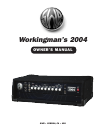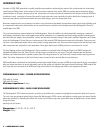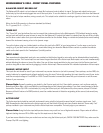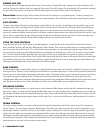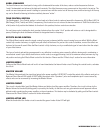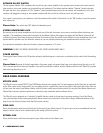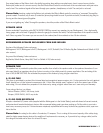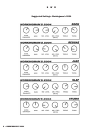
4 • WORKINGMAN’S 2004
PREAMP CLIP LED
The Preamp Clip LED will light whenever the Preamp, Tone section or output buffer reach clipping (run out of headroom). In the
event the Preamp clip indicator lights, turn down the Gain control. Since the Preamp Clip also monitors the Tone section, boosting
any one of the tone controls can cause the LED to activate. Again, turn down the Gain control if this happens.
Please Note: Constant clipping of the preamp will not harm the electronics in your Workingman's . However, damage can
occur to speakers due to near-DC content present in a clipped waveform. Do not defeat the limiter when overdriving the preamp.
GAIN CONTROL
The gain control adjusts the volume of the preamp section. After the Tone controls, Aural Enhancer and any effects you may be
using have been set to your liking, the Gain control should be set to where the Preamp Clip LED barely flashes upon hitting your
loudest note. After setting the Gain, use the Master Volume to set the desired volume level. Using these controls in this manner
assures the maximum signal-to- noise ratio with no distortion caused by the preamp circuits clipping. Since the Gain control is simi-
lar to a "pad", a small amount of signal will get through with the Gain control turned all the way down. The Gain also adjusts the
level sent to the Effects send jack. If your effect is being overdriven, turn down the Gain Control.
USING THE TONE CONTROLS
To get the most out of the Tone Controls of your Workingman's , it would be best to first understand how the Aural Enhancer
works, and how it interacts with the Bass, Midrange and Treble controls. Think of it as a variable tone curve, changing with its posi-
tion. As you raise the control from its "0", or fully counterclockwise position, you are elevating the whole range of sound (lows,
mids, and highs) at frequency points different than those selected for the individual Tone Controls. This remains true up to about
the "2 o'clock" position, at which point the mids start to drop off. The curves involved here are gentle, as opposed to the very
extreme curves you can create with the Tone Controls. Most significantly, the Aural Enhancer will raise the low end at a point lower
than the Bass control itself. For a 4-string bass, the Bass control itself will suffice. For the 5-string player, the Aural Enhancer will
help bring out the fundamentals of your instrument in the 30-60Hz range.
BASS CONTROL
The Bass control itself, as stated above, works in a range that will be useful under most "normal" conditions. Its musical use might
be thought of as a "fatness" control. Leaving the Aural Enhancer in a position lower than 12 o'clock will not boost the extreme bot-
tom so much as to make indistinct the working of the Bass control. The overall "punch" of your instrument, from your low E-string
on up about two octaves (midway up the G- string), will be determined with this control. With passive instruments, this will be
straightforward. With active instruments having bass-boost controls more exploration will be worthwhile. (Some active tone circuits
have boost-cut controls such as Tobias, Sadowsky, etc. Others such as Music Man, may be straight boost controls).
MID RANGE CONTROL
The Mid Range control operates in a crucial area for most instruments. Many basses, particularly with roundwound strings, can
have a very "honky", or nasal, sound. Dropping the Mid Range control can go a long way toward smoothing out your tone. We sug-
gest, though, that what sounds best when your listening to your tone by yourself may not be what works best in a band or record-
ing. Sometimes that objectionable quality may be just the right "hair" on your note to still have an audible presence in the track or
on stage.
TREBLE CONTROL
The Treble control operates in a tonal area that extends through and beyond the usual Treble control range. The Transparency
control "kicks in" at a much higher frequency. Boosting the control will open up the sound of a dull instrument, particularly in con-
junction with a tweeter, should you have one in your speaker system. However, this is also the range of string rattle, finger slides,
pickup clicks, etc. Again, we recommend you experiment with the control alone with your instrument while finding your tone, and
listen again in a band context, both near to and away from your speaker system. Qualities like punch, fatness, presence and bite
can be fairly well spread out. Treble, despite the broad dispersion of most tweeters, is a very directional quality. Spend some time
exploring what you can hear in this area as you move around.



